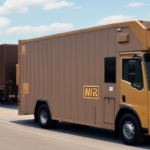Understanding Economy Shipping Times for Your Business
As a small business owner, offering diverse shipping options is crucial to meet customer expectations and manage costs effectively. Economy shipping stands out as a popular choice, allowing businesses to reduce shipping expenses by opting for slower delivery times. This article delves into the advantages and disadvantages of economy shipping, the factors influencing shipping durations, and strategies for selecting the optimal carrier for your business needs.
Importance of Economy Shipping for Small Businesses
Small businesses often operate with limited budgets and resources, making cost-effective shipping solutions essential. Economy shipping offers a viable way to minimize shipping expenses, enabling businesses to provide competitive pricing to their customers. This shipping option is particularly appealing to customers who prioritize cost savings over speed.
Cost Savings and Competitive Pricing
By choosing economy shipping, businesses can significantly reduce their shipping costs. According to a ShipScience report, economy shipping can lower shipping expenses by up to 30% compared to expedited options. These savings can be passed on to customers through lower product prices, enhancing the business's competitive edge.
Enhanced Customer Loyalty
Offering affordable shipping options can boost customer satisfaction and loyalty. Customers who recognize the value of economical shipping are more likely to return for future purchases, fostering repeat business and positive word-of-mouth referrals.
Leveling the Playing Field with Larger Retailers
While big-box retailers often provide free or discounted shipping, small businesses can compete by offering economy shipping. This approach allows smaller enterprises to maintain profitability without compromising on shipping affordability.
How Economy Shipping Operates
Economy shipping leverages slower delivery methods to reduce costs. Typically, this involves using ground transportation instead of air, consolidating shipments, and utilizing cost-effective delivery networks.
Transportation Methods
Ground transportation is the backbone of economy shipping, offering a more affordable alternative to air freight. This method not only cuts costs but also tends to have a lower environmental impact.
Shipment Consolidation
Consolidating multiple shipments into a single package or pallet helps reduce overall shipping costs by minimizing the number of trips required to deliver goods.
Tracking and Eligibility
While economy shipping may offer basic tracking features, it's important to verify whether your products are eligible. High-value or fragile items may require more secure and expedited shipping options.
Advantages of Economy Shipping
- Cost Efficiency: Significant reductions in shipping costs can enhance profit margins.
- Sustainability: Ground transportation generally emits less carbon compared to air shipping, supporting environmentally friendly practices.
- Reliability: Economy shipping often adheres to a consistent delivery schedule, especially for non-urgent orders.
Disadvantages of Economy Shipping
- Longer Delivery Times: Slower transit periods may lead to customer dissatisfaction if not managed properly.
- Limited Tracking and Insurance: Reduced tracking capabilities and insurance options can increase the risk of loss or damage.
- International Shipping Challenges: Customs delays and additional fees can complicate international economy shipments.
Factors Influencing Economy Shipping Times
Several elements can impact the duration of economy shipments:
- Distance: Greater distances between pickup and delivery points naturally extend shipping times.
- Package Size and Weight: Larger or heavier packages may require more handling time.
- Weather Conditions: Adverse weather can delay transit times.
- Carrier Processing: Different carriers have varying processing speeds that affect overall delivery.
Economy vs. Expedited Shipping: Key Differences
Understanding the distinction between economy and expedited shipping is crucial for making informed shipping choices:
- Delivery Speed: Expedited shipping offers faster delivery, often within 1-3 business days, whereas economy shipping may take up to 7-10 business days.
- Cost: Expedited shipping is more expensive due to the urgency, while economy shipping is budget-friendly.
- Suitability: Expedited is ideal for high-value or time-sensitive items, whereas economy is best for non-urgent, cost-sensitive shipments.
Selecting the Right Carrier for Economy Shipping
Choosing an appropriate carrier is vital to ensure reliable and cost-effective economy shipping:
Assessing Carrier Rates and Services
Compare different carriers based on their economy shipping rates, service coverage, and additional features like tracking and insurance. Websites like ShipScience's Carrier Comparison can provide valuable insights.
Evaluating Customer Service
Reliable customer support is essential for resolving shipping issues promptly. Opt for carriers known for their responsive and helpful customer service teams.
Considering Environmental Impact
Choose carriers that prioritize sustainability. Carriers investing in green initiatives, such as using alternative fuels or optimizing delivery routes, contribute to reducing your business's carbon footprint.
Strategies to Reduce Economy Shipping Costs
Implementing cost-saving measures can further minimize economy shipping expenses:
Negotiating Rates with Carriers
Engage with carriers to negotiate bulk shipping discounts or favorable rates based on your shipping volume.
Optimizing Packaging
Use lightweight and appropriately sized packaging to lower shipping costs. Efficient packaging reduces dimensional weight charges and minimizes material costs.
Utilizing Carrier-Provided Supplies
Take advantage of free shipping supplies offered by carriers to save on packaging expenses.
Best Practices for Managing Economy Shipments
Effective management ensures smooth and efficient economy shipping processes:
- Implement a Tracking System: Use shipment tracking to monitor deliveries and proactively address delays.
- Communicate with Customers: Provide customers with clear expectations regarding delivery times and offer regular updates.
- Verify Shipping Information: Double-check addresses and shipment details to prevent errors and delays.
- Leverage Shipping Software: Utilize shipping software to automate processes like label printing and tracking, reducing manual errors.
Understanding International Economy Shipping
International economy shipping offers cost-effective solutions for businesses expanding globally, but it comes with unique challenges:
Delivery Times and Costs
International economy shipping can take longer due to customs processing and longer transit distances. Businesses must factor in these variables when setting customer expectations.
Customs and Import Regulations
Navigating complex customs requirements is essential to avoid delays. Accurate documentation and proper declaration of goods can streamline the shipping process.
Carrier Selection
Choose carriers experienced in international shipping to ensure compliance with various countries' regulations and to offer services like customs clearance and international tracking.
Common Mistakes to Avoid with Economy Shipping
Avoiding typical pitfalls can enhance the effectiveness of economy shipping strategies:
- Underestimating Delivery Times: Clearly communicate estimated delivery windows to prevent customer dissatisfaction.
- Poor Packaging: Ensure items are securely packed to minimize damage during transit.
- Lack of Tracking: Implement tracking to monitor shipments and address issues promptly.
- Ignoring Shipping Details: Verify all shipping information accurately to prevent misdeliveries.
Impact of COVID-19 on Economy Shipping
The COVID-19 pandemic has reshaped the economy shipping landscape by increasing demand and straining shipping networks:
- Increased Delivery Times: Supply chain disruptions and higher shipment volumes have led to longer delivery periods.
- Rising Shipping Costs: Elevated demand has driven up shipping rates, impacting business budgets.
- Enhanced Safety Protocols: Carriers have implemented new safety measures, affecting operational efficiency.
Businesses must adapt by diversifying shipping options, communicating delays proactively, and adjusting pricing strategies to mitigate pandemic-related challenges.
Future Trends in Economy Shipping
The economy shipping sector continues to evolve, driven by technological advancements and changing consumer behaviors:
- Automation and Robotics: Increased use of automated systems and robotics in warehouses can enhance efficiency and reduce costs.
- New Delivery Networks: Development of more extensive and efficient delivery networks can improve delivery times and coverage.
- Growth of E-Commerce: The ongoing expansion of online shopping fuels demand for reliable and cost-effective shipping solutions.
- Sustainability Initiatives: Greater emphasis on eco-friendly practices is pushing carriers to adopt greener technologies and reduce their carbon footprint.
Conclusion: Is Economy Shipping Right for Your Business?
Choosing to implement economy shipping depends on various factors, including your business's budget, the nature of your products, and your customers' delivery expectations. By weighing the benefits against the drawbacks and adhering to best practices, economy shipping can be a strategic choice that enhances profitability and customer satisfaction.
For more insights and tools to optimize your shipping strategies, explore resources from reputable sources like ShipScience.




















